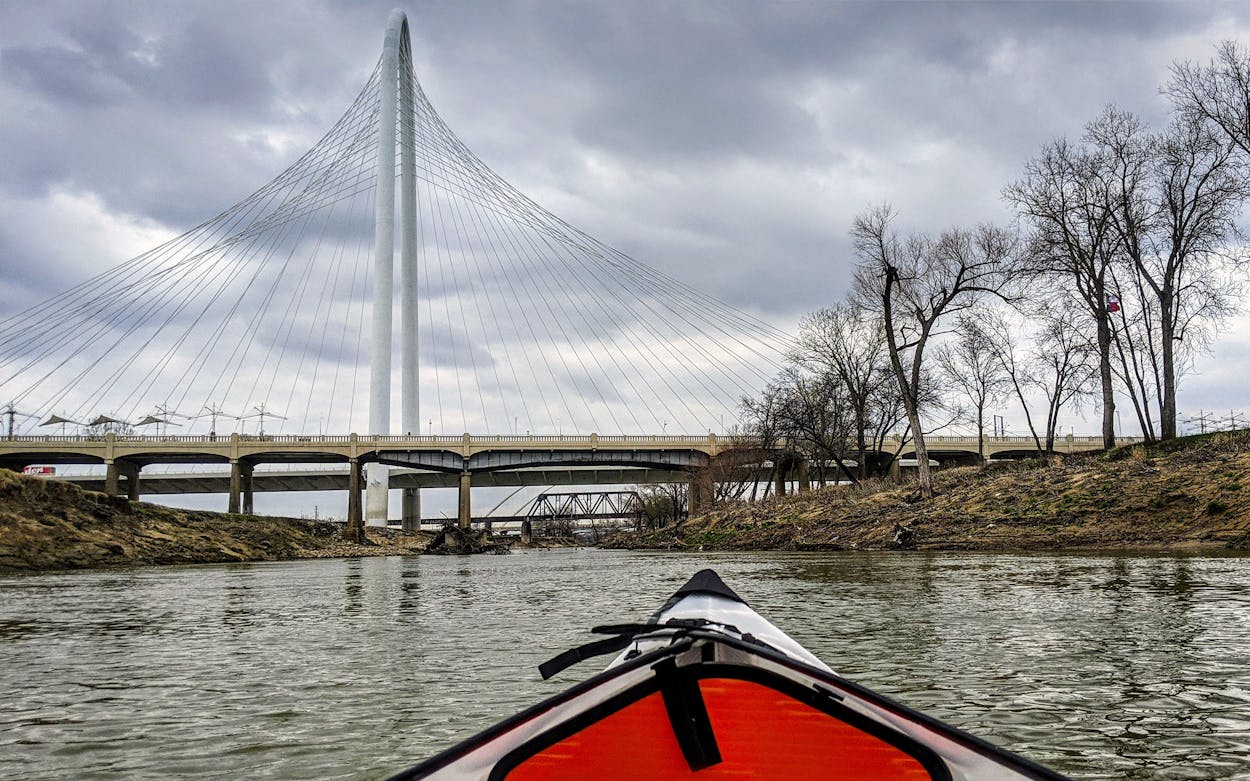Featured in the Dallas City Guide
Discover the best things to eat, drink, and do in Dallas with our expertly curated city guides. Explore the Dallas City Guide
I didn’t have much of a plan when I decided to take my kayak out on the Trinity River near downtown Dallas. I’d done just enough research to ensure that the weather and current were favorable and I’d be finished before five o’clock traffic. Work had been stressful, and I wanted to do something strenuous, fun, and full of wonder. Kayaking the Trinity River felt like my best option.
I’ve lived in Dallas since 2015, and though I’ve always been aware of the Trinity River, I didn’t put much thought into it until last year. I bought a house situated twenty minutes south of downtown Dallas and I cross the river by highway on a weekly basis. A few years ago, I tried to book a kayak trip through the Trinity River Audubon Center for my birthday, but I never went through with it. I regretted my decision every time I caught sight of the glittering water while driving.
Though I’ve kayaked through mangroves to a bioluminescent bay in Puerto Rico, at sunrise over a pod of whales in Los Cabos, and on a beautiful green lake in a national park in Thailand, I wouldn’t call myself an expert kayaker. I’m an adventurer who loves an outdoor challenge, especially if it feels unique or unusual—like kayaking through Dallas.
The Trinity River Paddling Trail is a National Recreation Trail with 21 official launch sites across 130 miles of river in the Dallas–Fort Worth area. Many companies and centers offer guided trips: I could have driven to Fort Worth and launched from Panther Island Pavilion with Backwoods Paddlesports or booked a river adventure on a section in Coppell with Trinity River Kayak Company, but I was drawn to the idea of paddling with the Dallas skyline in sight and under eight city bridges. The best launch site to do that was the Trammell Crow Park boat ramp in West Dallas.

At the boat ramp, I pulled my new Oru Kayak Inlet from the back seat of my Hyundai Accent. An employee from the Department of Public Works watched curiously from his truck as I assembled the foldable kayak in less than five minutes. I’d ordered the kayak a week before, and had practiced setting it up and breaking it down twice with the help of a YouTube video. It’s designed to be set up quickly, and because it doesn’t take much space when folded into a box, it’s the perfect kayak for an urbanite like me with a small car. I had tested the kayak for fifteen minutes on a lake the week before, but in my mind, the Trinity River Paddling Trail would count as my first true voyage.
I grabbed my paddle and buckled my life jacket, carried the kayak down the sloping boat ramp to the muddy edge of the water, then stepped in and floated to the middle. I figured I could disembark at a boat ramp downstream, fold the kayak into its compact box shape, and call a friend to pick me up and take me back to my car. (Even the southernmost boat ramp in the city is only a twenty-minute drive from downtown Dallas.)
The Caddo people called the Trinity River “Arkikosa.” That name rang in my head as I began paddling forward, disturbing a set of ducks nearby. Even though I spotted dozens of ducks and storks, I was surprised that I was the only soul on the river, especially since over five million people live within a thirty-minute drive of the trail. It’s not completely uncommon for Dallas locals and visitors to kayak the Trinity River. Articles, blogs, and kayaking and canoeing websites are available with instructions and accounts of locals paddling the Trinity. But in my six years living in Dallas County, I’ve never seen any kayakers on the river—at least not the part where I paddled. I have friends who kayak regularly, and instead of hitting the Trinity, they’ll drive hours to rivers near Austin or take their kayaks to White Rock Lake. I think about the times I’ve visited Austin and witnessed dozens of colorful kayaks, canoes, and paddleboards on Lady Bird Lake, right under the eye of downtown. As a Dallasite who would love to spend more time on the water, I wish it could be the same with the Trinity.
Instead, it’s mostly visited by residents cycling, running, or roller-blading on paved trails along the river, or professional and hobbyist fishermen in search of a catch. But there isn’t a kayak- or canoe-rental company set up on the Dallas section of the river (the Trinity River Audubon does offer kayak trips, but they remain unavailable because of the pandemic).
The river is set deep below steep levees, but the glistening exteriors of Reunion Tower, Fountain Place, Chase Tower, and others were still visible to my left. On my right, I paddled past two women sitting on a bench who looked down at me with puzzled expressions.
At 710 miles, the Trinity River is the longest river with its entire channel in Texas. Paddling south, the first bridge I approached was the Ronald Kirk Pedestrian Bridge, which connects Trinity Groves, an entertainment district with restaurants and shops, to downtown Dallas. Two little girls, who resembled me at that age with their tan skin and shoulder-length dark brown hair, stood on tiptoes to look over the edge and wave.
The Margaret Hunt Hill Bridge followed, and I became mesmerized by the 58 white cables that almost seemed to move as they led up to the four-hundred-foot steel arch. Tires on asphalt pounded above when I paddled under my next sites, the Commerce Bridge and the Margaret McDermott Bridge.
Despite the city hum, there were moments I forgot that I was paddling through the center of Dallas. The levees were lined with trees, and I spotted birds flying above and fish jumping from the water. At one point, something big moved fast below the surface of the water, creating a large wake as it raced beside me. I’d seen these signs when I lived in Louisiana, and I know that the river has been (and may still be) home to alligators. Fear settled in my stomach and I stopped paddling. Whatever it was continued swiftly past and went far ahead. Graffiti on the columns of the Trinity River Bridge and the tire of a discarded bike-share bike peeking from the water under the Jefferson Bridge pulled me back into my urban reality.
After I passed under the Interstate 35E bridge, the river became quieter and angled south, so I had to turn the whole kayak around if I wanted to see the skyline. For a foldable kayak, it held up nicely, though in the last two hours I’d managed to get some water in the bottom from the movement of my paddle. When I saw a flat and wide embankment on my left, I paddled over and jumped out. My feet sunk into half a foot of mud, but I managed to pull the kayak out and empty it of water before taking a break and refueling with almonds and chocolate.
The banks of this part of the Trinity River are more natural and untouched, which is not how I had imagined describing a river that flows through my metropolis. But the sounds of the city were gone, a line of thick trees covered the opposite side of the shore, and the mud was dotted with tracks of wild hog and birds.
As I enjoyed my snack break, I looked up and down the river, surprised that I was still alone. But maybe I shouldn’t have been, knowing the tumultuous relationship that Dallas residents have had with the body of water since the 1960s. It was then that the United States Public Health Service claimed the Trinity was “septic” and outrageously contaminated by urban and agricultural runoff, litter, and illegal dumping, and reports show that even today the Dallas section has high levels of E. coli. Still, the water is considerably better after major cleanup efforts, and it’s a water source for many in Dallas, but locals still joke, “Don’t swim in the river.” No one ever does. This month, the Texas Commission on Environmental Quality announced a plan to improve the water quality, so maybe it’ll be clean enough to wade in one day.
The area of the trail that I had just paddled, from the Ronald Kirk Pedestrian Bridge to the Margaret McDermott Bridge, may soon become a two-hundred-acre park named Harold Simmons Park. Overlooks will be positioned above floodable areas and will feature amenities like cafes, restaurants, playgrounds, and festival space. There are deep concerns in the community over the project—specifically over the expectation that it will create a new wave of gentrification in West and South Dallas, pushing out low-income residents who have always lived near the river. The calm and quiet I’d found on this waterway will change completely if the project breaks ground in 2022, as is tentatively planned.
I tried to paddle back upstream and toward my car for fifteen minutes, but my heart rate spiked to two hundred beats per minute, my arms were dying, and I didn’t get far, so I called a friend and asked her to pick me up at the next boat launch.
The last part of my 3.7-mile paddle trip was peacefully quiet and somewhat short. After passing under the Corinth Street bridge, I came upon my intended boat ramp near the Dallas Love Locks Bridge at Santa Fe Trestle Trail. (I was not far from where a disastrous, $4 million, man-made white-water feature called the Dallas Wave was installed in 2011. Experienced kayakers found the white-water rapids troublesome and dangerous to navigate, so they were removed in 2018 at the cost of $2 million.)
A fisherman watched me as I slipped in mud a few times pulling the kayak up the steep incline of the boat ramp. Cars pulled up nearby and families and friends jumped out with fishing poles in hand. They would make their way down to the river from whence I’d come. I hoped they might see another paddler on the Trinity River: someone I had just missed by ten minutes or an hour; someone who understood the beautiful and otherworldly experience of paddling in a space that is both urban and irrevocably wild.
- More About:
- Dallas






